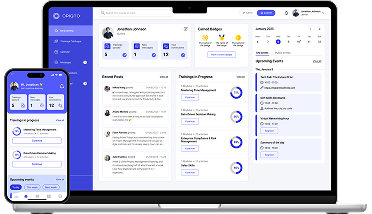Learning content is a backbone of education, so much so that high-quality learning materials can compensate for many other shortcomings such as large class size, unqualified teachers, time shortage, and a lack of support system outside of the classroom, which makes them the most cost-efficient way of tangibly improving learning outcomes. A good, well-thought-out coursebook can help students learn even when all odds are stacked against them.
But what makes quality learning content? Are there any specific properties it should have to be considered good? Should it be long and in-depth or short and concise? Let's see what options exist and what cognitive science has to say about them.
The ways content impacts learning outcomes
Acquiring knowledge is a complex process studied by many disciplines, from pedagogy and psychology to neuroscience and anthropology. At their crossroads stands cognitive science — an interdisciplinary study of the mind and intelligence.
According to cognitive science, human cognition is an information-processing system that follows several fundamental principles. The learning content that meets these principles is more effective than the content that does not.
Principles of human cognition
As an information-processing system, human minds store, transfer, change, and apply information. Our long-term memory is storage for knowledge, learning is a process of transferring and changing information, and the goal of learning is to use new knowledge in practice.
Moreover, skills and expertise are directly tied to long-term memory as it's an ability to recognize a familiar problem and choose a working solution among thousands encountered before. That's the basis behind the "10,000 hours of practice to become an expert" theory. The goal of training, especially professional, is thus to transfer applicable knowledge to long-term memory.
Cognitive load
But before new information can take its place in the storage, we need to process it, and while our long-term memory is practically inexhaustible, our processing capacities are very much limited. According to George A. Miller's observation, an average person can keep about seven objects or chunks of information in working memory.
Similarly, cognitive load theory suggests that our working memory can handle only so much information, and overload impedes our ability to process information. That's why poorly designed instructions yield worse learning results. Many things can overwhelm our minds — redundant, unnecessary, or overly difficult information. And the more intrinsically complex the subject is, the more new elements you need to process and the more susceptible you are to cognitive overload.
Interestingly, using the knowledge from long-term memory doesn't seem to overload our working memory. So the more you know about the subject, the more mental capacity you have for learning new stuff about it.
Memory curve and spaced repetition
Another question is how to retain new knowledge.
From 1880 to 1885, psychologist Hermann Ebbinghaus ran an experiment where he would memorize random syllables and then check how many of them he remembered after specific periods. The result was the "forgetting curve" that was confirmed in a similar study in 2015:
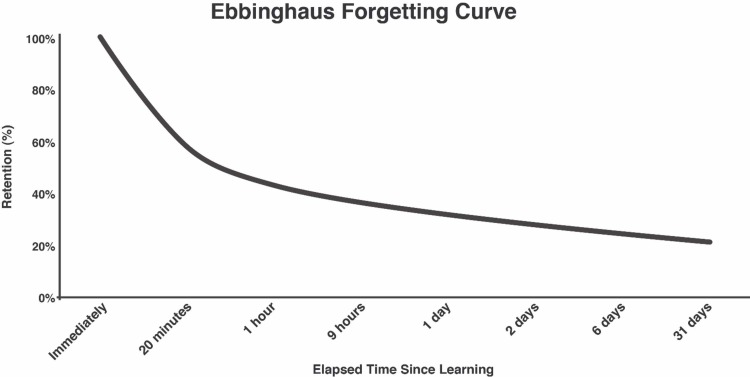
According to the Ebbinghaus curve, we forget information over time if we don't use it. The speed of forgetting depends on the difficulty of the learned material, its relevance, the person's physiological and psychological state, etc. To improve retention, he proposed memory training with the help of mnemonic techniques and periodic recall in the form of testing, practicing, and other forms of spaced repetition.
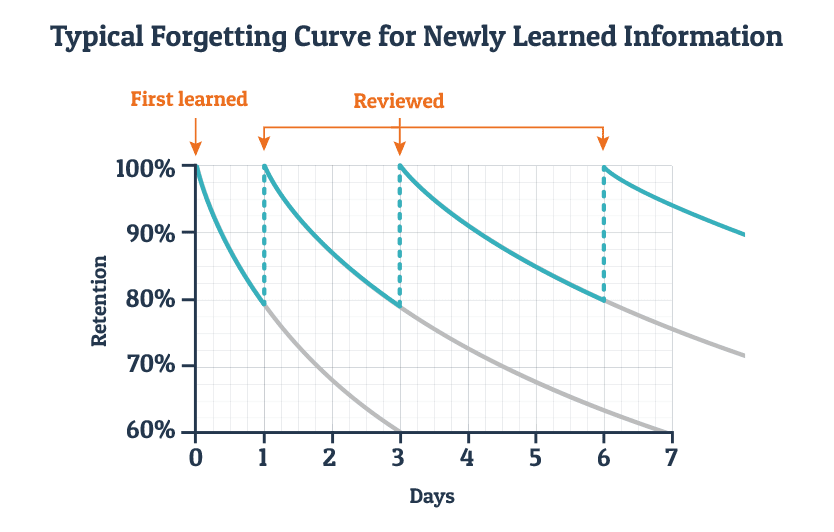
What does it mean for instructional design?
The key takeaways are:
- The learning goal is the transfer of knowledge to long-term memory.
- Learning content should be well-structured to minimize cognitive load.
- To retain new knowledge, one needs to recall it repeatedly.
Many other factors affect learning, such as the cognitive load of combining different content formats, e.g., text and audio, the role of internal and external motivation, the effectiveness of theoretical knowledge compared to practice and live experiments, etc. However, the bottom line is that learning content that recognizes the human cognitive constitution will be more effective.
The problem is there are two directions based on different cognitive processes one could go, following the framework of cognitive science — macrolearning and microlearning.
Macrolearning refers to a traditional approach to learning that involves a comprehensive and in-depth study of a subject or topic over an extended time. It typically involves structured courses, lectures, textbooks, and other resources that cover a wide range of concepts and provide a holistic understanding of the subject matter.
Macrolearning arranges information coherently, connecting new information with existing knowledge, creating associations, deepening understanding, and facilitating retrieval and comprehension. It provides scaffolding and allows us to build up the difficulty and depth of the information gradually. Macrolearning also encourages meaningful learning, wherein learners actively engage with the subject matter, relate it to their prior experiences, and create mental representations. This process fosters comprehension and long-term retention of information.
Microlearning, on the other hand, focuses on delivering small, bite-sized pieces of information that are easy to consume and understand. It involves short learning modules, videos, quizzes, or interactive content that can be completed quickly.
Breaking down information into smaller, manageable chunks or modules reduces cognitive load and supports retention. Microlearning is also well-suited for spaced and distributed practice and active recall via quizzes and assessments, which enhances long-term memory retention. By providing regular, spaced learning intervals, microlearning can optimize memory consolidation, while retrieval practice strengthens memory retrieval pathways, improves long-term retention, and enhances learning.
Macrolearning and microlearning leverage cognitive processes in different ways. Macrolearning focuses on deep comprehension and constructing a comprehensive knowledge base, while microlearning emphasizes targeted learning experiences that enhance retention and reinforce specific concepts. Understanding which environment and context fit each approach can inform instructional design and optimize learning outcomes.
Macrolearning and long-form content
As mentioned above, macrolearning allows learners to develop a comprehensive understanding of a subject by exploring it in detail and painting a broader context for the subject matter, helping learners connect different concepts and ideas. To do that, this approach usually employs long-form learning content. Here are some common types of long learning formats.
Long-form content types
Textbooks and study guide Comprehensive written materials that cover an entire course or subject area in detail. Textbooks typically include explanations, examples, exercises, and additional resources. And study guides consolidate information from various sources into a single comprehensive resource for exam preparation or self-study purposes.
Courses, offline and online: Structured educational programs that span a longer duration, such as semester-long or year-long courses. These curricula often include multiple modules or units covering various topics.
Research papers, theses, and dissertations: Scholarly articles that present original research findings, theories, or analyses in a specific academic field. Research papers are usually longer and follow a particular format, including literature reviews, methodologies, results, and discussions.
Academic books and journals: In-depth publications authored by experts in a particular field, extensively covering a specific subject or topic, and periodical publications publishing scholarly articles within a discipline.
Lectures: A sequence of in-person or recorded lectures delivered by an expert on a specific subject. Lecture series can cover a comprehensive range of topics, providing in-depth knowledge and insights.
Long-form materials effectiveness
As you can see, long learning formats are characterized by their extensive and comprehensive nature, providing in-depth coverage and allowing for a thorough understanding of a subject. They offer extensive explanations, examples, and evidence, requiring learners to think critically, analyze, and synthesize complex ideas.
However, long-form content is time-consuming to produce and may not accommodate individual learning preferences or pace.
As for the learners, going through long content requires a significant time commitment, making it challenging for people with busy schedules, and the extensive amount of information can sometimes overwhelm learners.
That's why long-form materials are predominantly used in higher education and academic settings, where the depth of knowledge and scholarly analysis is valued, time constraints are not an issue, and professional educators can adjust cognitive load depending on the audience. But overall, long learning formats are indispensable for learners who require in-depth understanding, advanced knowledge, or specialized expertise in a particular subject.
Learning approaches for long-form content
Here are some learning approaches that make effective use of long-form content to deliver comprehensive and in-depth educational experiences:
Traditional classroom instruction: Long-form content, such as textbooks, lectures, research papers, and academic readings, is integral to comprehensive courses or programs that span over a longer duration, such as semester-long or year-long courses, and is commonly used in traditional classroom settings to provide foundational knowledge and serve as reference materials for in-depth study.
Project/problem/research-based learning: Case studies and scenarios, research papers, and other long-form content can be incorporated into learning approaches, where learners engage in extended, in-depth projects that require research, analysis, and synthesis of the information to solve real-world problems or complete complex tasks, develop problem-solving skills, and engage in independent investigation.
Seminars and workshops: Long-form content is often utilized in seminars and workshops to facilitate in-depth discussions, debates, and exploration of complex subjects among participants.
Advanced and specialized education: Long-form content is commonly employed in advanced education settings, such as graduate programs or specialized courses, where learners delve deeply into complex theories, research methodologies, and subject-specific knowledge.
These approaches leverage the benefits of long-form content, such as comprehensive coverage, detailed analysis, and extensive resources, to foster in-depth understanding, critical thinking, and advanced knowledge acquisition among learners. Long-form content provides opportunities for learners to engage with complex ideas, conduct extensive research, and explore topics in greater depth.
Microlearning and short-form content
In this article, we use "microlearning" as an umbrella term for a plethora of approaches utilizing short, condensed learning sessions with equally short and condensed content.
The idea behind microlearning is to remove as many barriers between the learner and the training as possible, mainly time limitations and low motivation. With the spread of smartphones and mobile internet, the perfect means to deliver concise and focused content to learners, microlearning exploded in popularity.
Short-form content types
Microlearning modules: Brief and self-contained learning units that cover a specific topic or learning objective. They are typically designed to be consumed in short bursts and can include videos, quizzes, or interactive activities. What puts true microlearning apart from any other fast learning approach is that it contains a Minimal Independent Feedback Loop. A learner should obtain new information, complete a task or assessment, get feedback, and reflect on their result.
Infographics: Visual representations that present information, data, or concepts using graphics, charts, and diagrams in a concise and visually appealing manner.
Video snippets: Short video clips that deliver key information or demonstrate a specific concept. They are often used as standalone resources or incorporated into larger instructional materials.
Podcast episodes: Audio recordings or episodes that cover specific topics and provide educational content. They are typically shorter in duration and can be easily consumed during commutes or downtime.
Quick-reference guides: Cheat sheets that provide concise summaries, tips, or instructions on a particular subject or process.
Flashcards: Bite-sized cards that present information, definitions, or questions on one side, with corresponding answers or explanations on the other side. Flashcards are commonly used for memorization and self-testing.
Social media posts: Short educational content shared on social media platforms, such as Twitter, Facebook, or Instagram. These posts often deliver bite-sized information, facts, or tips.
Short articles or blog posts: Short-form written content that concisely covers a specific topic or concept. These articles provide quick insights or overviews.
Quizzes and assessments: Brief assessments or quizzes test learners' knowledge or understanding of a subject. They typically focus on a specific set of questions or learning objectives.
Gamified learning activities: Short, interactive games or simulations provide engaging and interactive learning experiences within a condensed timeframe.
These are just a few examples of short learning mediums. The choice of format depends on the specific learning objectives, target audience, and the nature of the content being delivered.
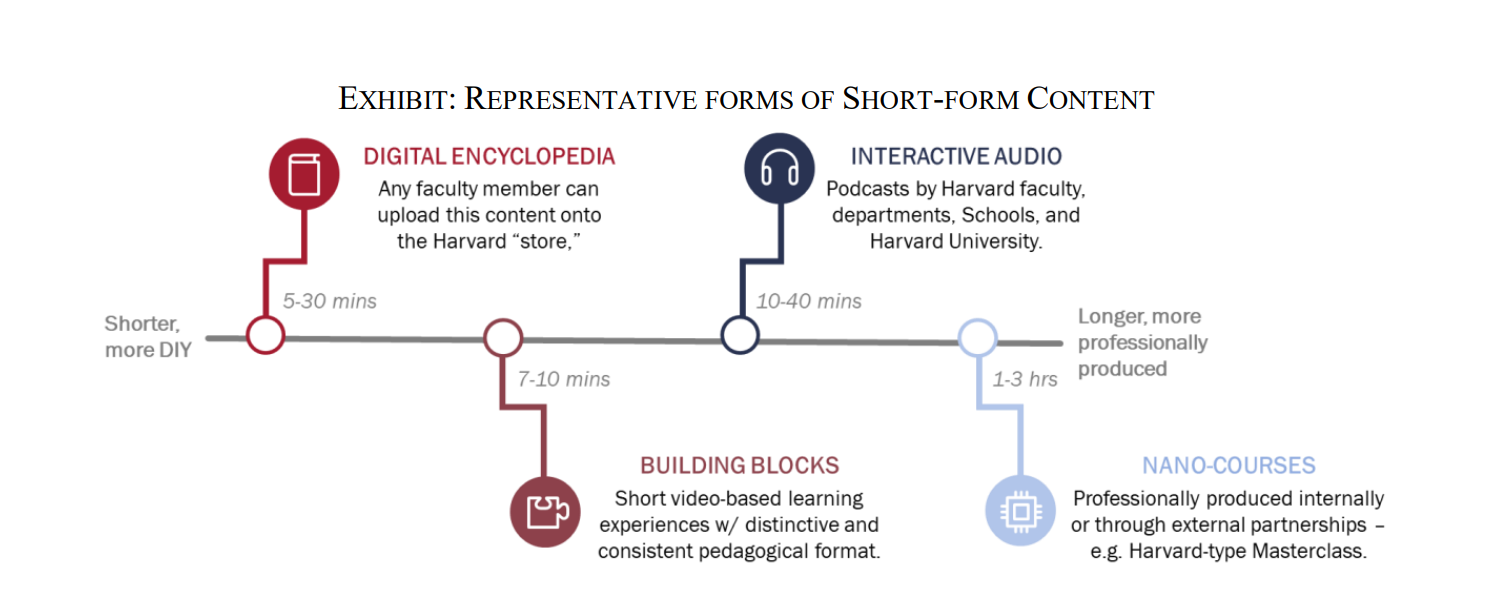
Short-form materials effectiveness
Short learning formats aim to deliver information efficiently and engage learners in a shorter span of time, making them particularly suitable for quick references, review sessions, or just-in-time learning needs.
The distilled and easily digestible format can aid in better information retention and recall, allowing for greater flexibility in time, access, and personalization. Learners can engage in short learning activities whenever and wherever they prefer, and it's much easier to tailor short content to individual needs, be it a topic, a skill, or a media format preference.
Short-form content, such as flashcards or brief quizzes, is used in a spaced repetition to reinforce learning over time. Learners regularly review and engage with the content, enhancing retention and long-term memory, and show better test results when the course is split into smaller modules.
Also, as you can notice, short-form content is much more varied and often utilizes visuals, graphics, and multimedia elements that make it more appealing and engaging. As a result, learners even tend to finish lessons faster.
However, as a standalone medium, short-form content will always fall short of providing the same depth and comprehensive understanding as long-form content, especially for complex or highly technical subjects requiring extensive study. Not every topic can be chunked down easily. And even when it can, relying on microlearning and small chunks of information may result in fragmented knowledge that lacks a cohesive structure. Short-form content is not a silver bullet but an aid.
Learning approaches for short-form content
These are some learning approaches that leverage the benefits of short-form content, such as brevity, accessibility, and focused delivery, to enhance engagement, knowledge retention, and learner performance:
Microlearning: The microlearning approach breaks down complex topics into short, focused, and easily digestible units or lessons that can be completed within a few minutes. It often leverages multimedia elements such as videos, infographics, quizzes, or interactive exercises.
Just-in-Time Learning: This approach focuses on delivering short bursts of targeted information as performance support to provide immediate assistance or guidance to learners in their work environment. These quick-reference guides, checklists, or instructional videos usually appear automatically to address any issues the learner can encounter in real-time. Take pop-up tips in the newly installed software as an example.
On-demand learning: On-demand learning refers to the learner's ability to access educational content whenever needed, without being bound by time or location. It often involves self-paced learning, where learners have control over the content, pace, and duration of their learning experience.
Mobile learning: Short-form content is particularly suited for mobile learning, as smaller screens and slower internet access don't impede user experience much compared to long content formats, and it fits into brief time slots or on-the-go situations.
Flipped learning: In a flipped learning model, short-form content is often used as pre-work or preparatory material before in-person or synchronous sessions. Learners engage with concise resources, such as videos or readings, to acquire foundational knowledge independently, freeing up classroom time for interactive discussions and activities.
Social learning: Short-form content plays a role in social learning, where learners share and exchange information, insights, or resources with their peers via messages, comments, forums, blog posts, etc. Social media platforms, discussion forums, or collaborative spaces facilitate sharing of short-form content for collaborative learning experiences.
Gamified learning: Gamification incorporates short-form content, such as quick challenges, quizzes, or interactive elements, to engage learners in game-like experiences. Points, badges, or leaderboards provide motivation and encourage learners to interact with short bursts of educational content.
By utilizing short-form resources strategically, educators can cater to learners' preferences for concise information and accommodate their learning needs in proper contexts.
Tips on combining long-form and short-form content
In practice, combining both macrolearning and microlearning is the most beneficial. Macrolearning can lay the foundation and provide a broader understanding, while microlearning can reinforce specific concepts, provide just-in-time learning, and support ongoing skill development. The choice between macrolearning and microlearning depends on the learning goals, available time, expertise level, and individual preferences.
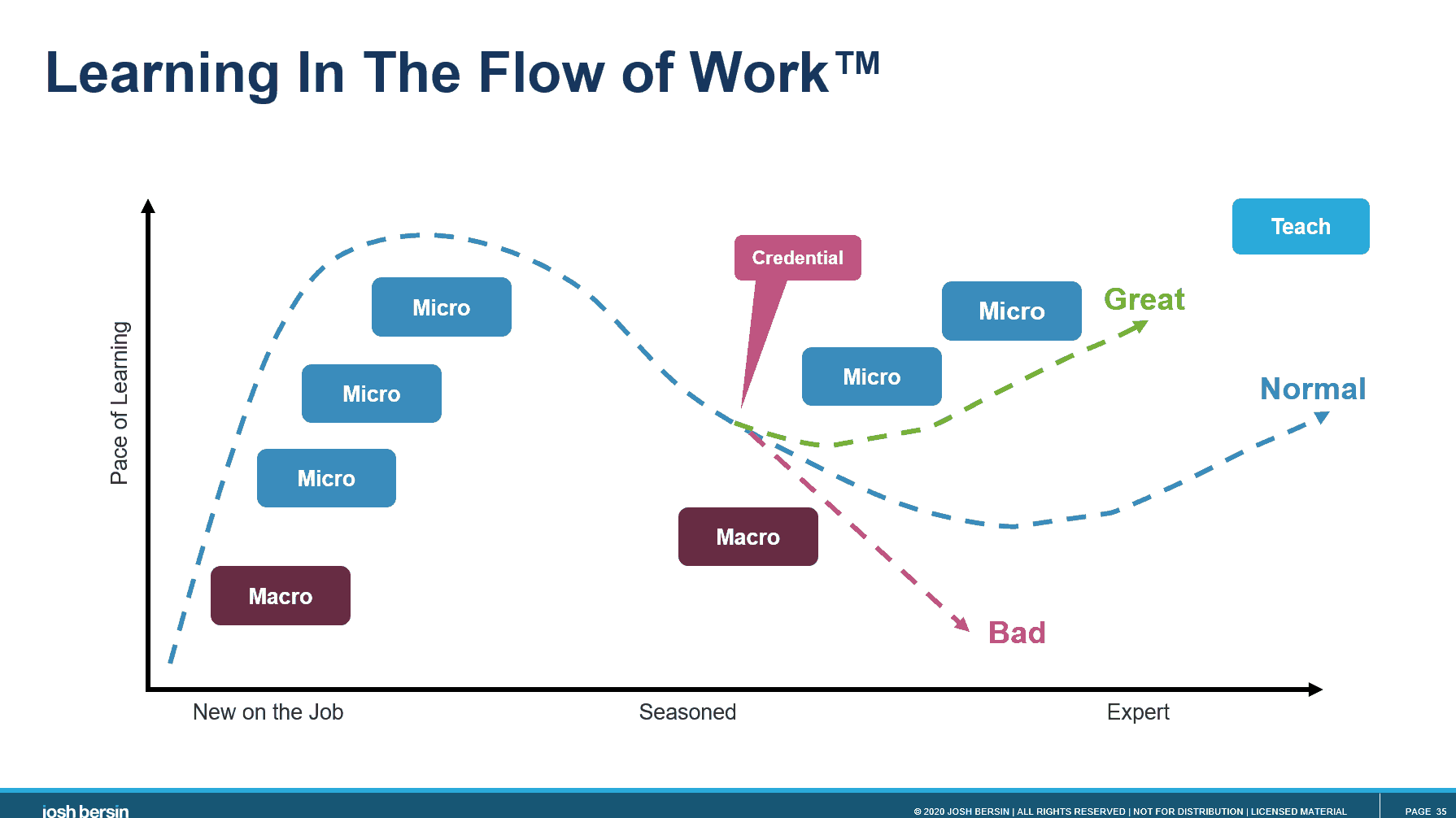
Here are some tips on how to leverage the benefits of both formats:
Set clear learning objectives
Determine the specific learning objectives you want to achieve. Identify which topics or concepts require in-depth understanding (suitable for long-form content) and which can be delivered more concisely (suitable for short-form content).
Scaffold learning
Start with an overview of short-form content, such as videos, infographics, or summaries, to introduce learners to a topic. This can provide a foundation and familiarity with the subject, enabling learners to extract more value from the long-form content afterward. The more experienced the learner gets, the more equipped they are for long and complex content.
Chunk long-form content
Break down long-form content into smaller manageable self-contained sections or modules to help learners process it. Each module can be complemented with short-form resources, such as summary notes or visual aids, and assessment and feedback in the form of a quiz to complete the learning cycle, reinforce key concepts, and enhance retention.
Add interactivity
Combine long-form and short-form content in interactive activities that promote active learning. For example, learners can study long-form content, such as a research paper, and then engage in group discussions or debates facilitated by short-form prompts or questions.
Recap and review
Use short-form content, such as recap videos or summaries, to reinforce and consolidate key takeaways from long-form learning experiences. This helps learners review and solidify their understanding of the core concepts.
Personalize learning
Tailor the learning experience to individual learners' needs by providing a mix of long-form and short-form resources so that learners can choose their preferred formats based on their learning styles, preferences, and time constraints.
Assess, provide feedback, and encourage reflection
Design assessments that integrate both long-form and short-form elements. For example, include a mix of in-depth essay questions (long-form) and quick multiple-choice quizzes (short-form) to evaluate learners' comprehension and application of knowledge and promote deep learning. Encouraging learners to reflect on their learning experiences through journals or discussion forums can complement long-form reflections or self-evaluations.
Combining long-form and short-form learning approaches allows you to create a dynamic and engaging learning environment that promotes deep understanding, active participation, and efficient knowledge acquisition. The key is strategically integrating these formats based on the learning objectives, content complexity, and learners' needs.
And if you need a hand in building an engaging, interactive course, Opigno can help — contact us for more info.
Published on July 4, 2023.
